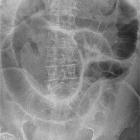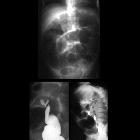sigmoid volvulus




























Sigmoid volvulus is a cause of large bowel obstruction and occurs when the sigmoid colon twists on its mesentery, the sigmoid mesocolon.
Epidemiology
Large bowel volvulus accounts for ~5% of all large bowel obstructions, with ~60% of intestinal volvulus involving the sigmoid colon . It is more common in the elderly .
Clinical presentation
Symptoms are that of a large bowel obstruction: constipation, abdominal bloating, nausea and/or vomiting. Onset may be acute or chronic.
Pathology
Aetiology
There is a wide range of causes; some are geographically-specific :
- chronic constipation and/or laxative abuse
- fibre-rich diet (especially in Africa)
- Chagas disease (especially in South America)
Associations
- chronic neurological conditions (e.g. Parkinson disease, multiple sclerosis, pseudobulbar palsy)
- medications from chronic psychiatric conditions (e.g. chronic schizophrenia)
Radiographic features
Sigmoid volvulus is differentiated from a caecal volvulus by its ahaustral wall and the lower end pointing to the pelvis.
Plain radiograph
Abdominal radiographs will show a large, dilated loop of the colon, often with a few gas-fluid levels. Specific signs include:
- coffee bean sign
- Frimann-Dahl sign - three dense lines converge towards the site of obstruction
- absent rectal gas
- liver overlap sign
- northern exposure sign
Fluoroscopy
Although now uncommonly performed, a water-soluble contrast enema exquisitely demonstrates this condition, with the appearances described as the beak sign (or bird beak sign).
CT
- large gas-filled loop lacking haustra, forming a closed-loop obstruction
- whirl sign: twisting of the mesentery and mesenteric vessels
- bird's beak sign: if rectal contrast has been administered
- X-marks-the-spot sign: crossing loops of bowel at the site of the transition
- split wall sign: mesenteric fat seen indenting or invaginating the wall of the bowel
Treatment and prognosis
Endoscopic detorsion (e.g. rigid/flexible sigmoidoscopy, colonoscopy) in sigmoid volvulus cases without ischaemia or perforation successfully treats ~80% (range 60-95%) of patients and is recommended as the initial treatment . Occasionally patients suffer from recurrent sigmoid volvulus, for which a surgeon may consider sigmoid colopexy (surgical fixation of the sigmoid colon), or in the surgically unfit, a percutaneous endoscopic colostomy (PEC) might be performed.
The mortality rate is 20-25% . The most serious complication is bowel ischaemia.
Differential diagnosis
- large bowel obstruction from other causes
- caecal volvulus: to differentiate between sigmoid volvulus and caecal volvulus please refer to sigmoid volvulus versus caecal volvulus article
- colonic pseudo-obstruction
Siehe auch:
- Kaffeebohnenzeichen
- Whirlpool-Zeichen
- Volvulus
- Volvulus des Coecums
- Colon sigmoideum
- Mesenterium
- Mesocolon sigmoideum
- Sigmavolvulus bei Kindern
und weiter:

 Assoziationen und Differentialdiagnosen zu Sigmavolvulus:
Assoziationen und Differentialdiagnosen zu Sigmavolvulus:

